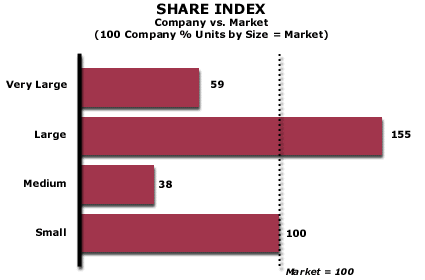Analysis 6: Company Share Index by Customer Size
EXHIBITS:

| HOW TO INTERPRET THE ANALYSIS: In the exhibit, the company is very weak with Very Large and Medium sized customers. It is at average market strength with Small customers and has much stronger than average share with Large customers.
The exhibit in this analysis is in index form. Let us assume for the moment that the Very Large customer segment has 50% of the total industry volume. This chart would then say that the particular company being measured has 29.5% (i.e., 59% times 50% equals 29.5%) of its total sales in the Very Large customer category. Similarly, let us assume that the Large customers in the market have 30% of the industry volume. The exhibit would then show us that the company being measured had 46.5% (i.e., 155% times 30% equals 46.5%) of its sales in the Large customer category. PURPOSE: This analysis measures the company's performance on penetration of segments defined by size of customer compared to the average competitor. APPROACH: To complete this analysis, the company should allocate its total sales by customer size segment. Divide the company's total sales into the sales the company makes in each segment to arrive at a percentage. The sum of the percentages of sales by customer size segments equals 100. The company would complete the same analysis for the industry as a whole. It then would divide the industry's percent of sales by size of customer into the company's sales by size of customer to produce the index. An index is a measure of the performance of one entity relative to another entity. The index is the ratio of the performance of the first entity divided by the performance of the second and then multiplied by 100. An index above 100 indicates that the first entity has a higher result than the second entity. An index below 100 indicates that the first entity has a lower result than the second. The resulting indices give an indication of the company's strength or weakness by customer size segment. Where the index is below 100, the company's market share is below its average for the market. Where it is above 100, the company share is above average. In the example above, the company is weak in the Very Large customer category and very strong in the Large customer category. Because these two customer segments make up 80% of the total volume in the marketplace, the company should concentrate on understanding the reasons for relative strengths and weaknesses with these customers compared to the market. |
|
Recommended Reading |
| For a greater overall perspective on this subject, we recommend the following related items:
Analyses: |
||||||||
Symptoms and Implications: Symptoms developing in the market that would suggest the need for this analysis.
|
||||||||
Perspectives: Conclusions we have reached as a result of our long-term study and observations.
|
